Many of the secondary effects caused by a TBI can be managed through traumatic brain injury recovery exercises. Rehabilitation provides many benefits such as improving movement, rebuilding strength, and restoring cognitive function.
Finding fun, engaging exercises helps keep you motivated and ensures you make the most out of your recovery. To help you navigate the rehabilitation process, we’ve gathered 20 of the most effective physical and cognitive TBI exercises to do at home.
Benefits of Traumatic Brain Injury Recovery Exercises
After a traumatic brain injury, neural pathways may become damaged, and the effects depend on the location and severity of the injury. Without healthy neural pathways, the brain may have difficulty communicating with the affected muscles.
Fortunately, the brain is versatile and has the ability to rewire itself through neuroplasticity. Neuroplasticity strengthens existing neural pathways and creates new ones, which helps improve overall function after a TBI.
There are various types of TBI and generally speaking, milder traumatic brain injuries have higher chances of recovery. However, there is hope for recovery from a moderate or even a severe traumatic brain injury with consistent exercise. Again, the key to recovery is neuroplasticity, which is best activated through high repetitions of exercise, or massed practice. The more a skill is practiced, the more the brain will recognize and adapt that function.
Neuroplasticity aside, exercise also helps increase blood flow to your brain. Proper blood flow is necessary for the body to function efficiently, but it can often be reduced after a TBI due to lack of movement. Thus, the more you exercise, the more blood flow will increase to provide essential oxygen and nutrients throughout the body.
Be Cautious When Creating Your Post-TBI Exercise Regimen
It’s important to note that sometimes TBI survivors experience other types of injury at the same time such as broken bones, muscular strains, or wounds. These injuries often require surgery and/or special precautions such as avoiding heavy weights or strenuous movements.
In addition, the rehabilitation process differs when dealing with a traumatic brain injury compared to a stroke. After a stroke, it is widely recognized that early intensive rehabilitation is best for maximizing recovery. However, after a traumatic brain injury, the brain and nervous system are in a lot of physiological distress and are highly sensitive.
The “neuro-metabolic cascade” that occurs even after a mild TBI like a concussion is why individuals may experience sensitivity to bright lights and sounds, headaches, dizziness, or nausea with physical exertion. Therefore, after a traumatic brain injury, rehabilitation and exercises must be done in a graded, step-wise manner that closely monitors how the body is responding to increasing physical challenges and mental stimulation.
Therefore, it’s important to listen to your body and how it responds to the following exercises. Be sure to consult with your therapist before trying any new exercises to ensure they are safe for you. Remember to start with exercises suitable for your ability level and increase the challenge as you improve. The more you practice, physically and mindfully, the more likely you will see positive results.
There are various types of TBI exercises that help target different muscle groups. While choosing which exercises to do can seem overwhelming, we’ve compiled a list of the top TBI exercises to help you get started.
Leg Exercises for TBI Survivors
The following TBI exercises will target the legs, which can help improve standing balance and gait. We will move onto other muscle groups after this section.
Seated Hip Internal/External Rotation

For this brain injury recovery exercise, you will need a towel. Start in a seated position, and place a towel under your foot to make it easier to move. Then, slide your foot towards your midline and push your legs outward to the side. Use your hands to assist if necessary. Repeat 10 times, then switch to the other leg. Do 3 sets of 10.
Seated Hip Abduction/Adduction
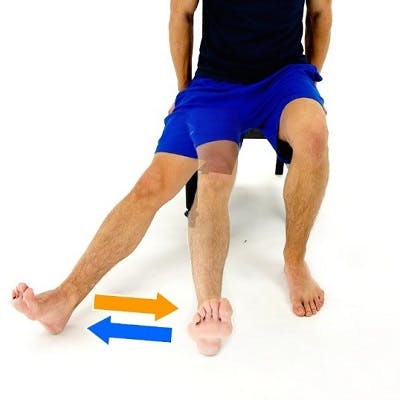
Begin by sitting in a chair and holding one leg slightly above the floor. Then, kick your leg out slowly as far as you can, then inward toward your midline. This can also be done by sliding your whole leg out and in on a towel. Aim for 3 sets of 10 as well on each side.
Seated Marching
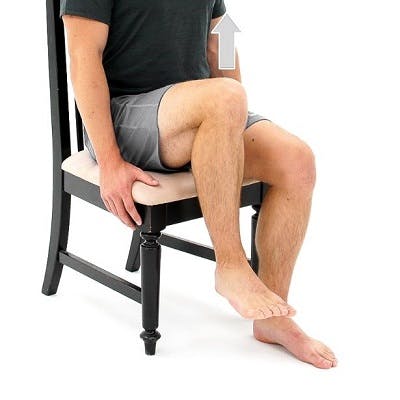
This TBI exercise is performed in a seated position while maintaining tall, upright posture. First, lift your knee up toward your chest and hold for 1-2 seconds. Then, slowly bring it back down. Repeat alternating sides for a total of 20 repetitions. This can be done passively by using your arms or actively using just your leg strength.
Straight Leg Raises
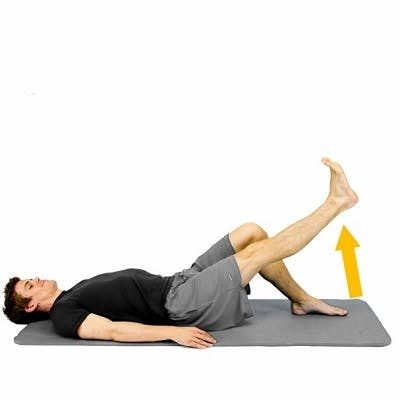
Straight leg raises are a great traumatic brain injury recovery exercise to develop quadriceps strength. Lay flat on your back either on the floor or a bed with one knee bent. With the other leg, straighten the knee and lift your leg upwards. Make sure to keep your knee fully straight by contracting your thigh muscles as you lift your leg up and down. You can wrap a resistance band around your ankles to make it more challenging. Try to do 3 sets of 10 on each leg.
Core Exercises for Brain Injury Recovery
Up next, we will target the core with a few therapeutic exercises for traumatic brain injury recovery. A strong core is essential for balance and stability throughout any activity, such as walking, standing, and sitting. These are a staple in any TBI exercise regimen.
Lateral Trunk Flexion (Oblique Crunches)
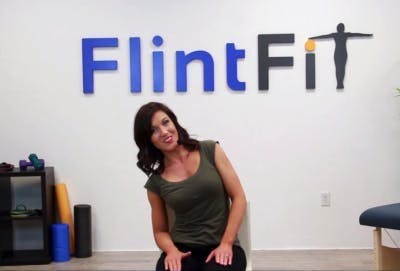
Start this core TBI exercise seated in a chair. Then, dip your right shoulder down towards your right hip. Next, use your core to pull your trunk back up to center with good posture. Dip your left shoulder down to your left hip, and pull yourself up again (if needed, you can use your arm to help push you back up). Repeat about 15 times on each side.
Forward Punches
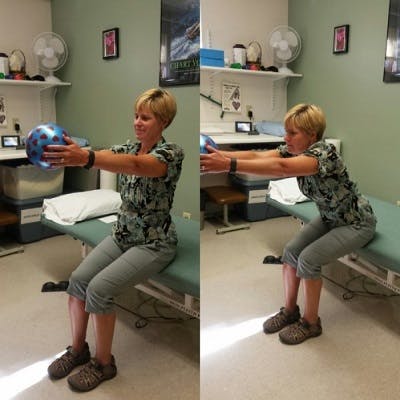
While seated, clasp your hands together and slowly punch forward while keeping your arms parallel to the floor. Lean forward as far as you can. Then, use your back muscles to pull your trunk back to an upright position. You should feel this in your shoulders, back, and core. Repeat about 10 times, but make sure to stop immediately if you feel any pain or discomfort in your back.
Seated Trunk Extension
Another helpful core exercise for brain injury recovery is seated trunk extension. For this exercise, sit in a chair with your arms crossed over your chest. Then, bend at the waist to slowly lean forward as far as you can safely without falling over. Then, use your back muscles to push yourself back up. Again, you may use your arms to give yourself a boost. Repeat 3 sets of 15.
Seated Oblique Crunches

This is one of the more advanced TBI exercises on this list and may take a little more coordination. Start sitting tall in a chair with your arms crossed over your chest or hands behind your head. Then, crunch your right elbow to your left knee by bringing them together, then returning back to an upright position. Alternate sides and repeat for a total of 20 repetitions.
Balance Exercises for TBI
While core exercises help improve balance, there are other TBI exercises that can help with balance, which you will find below. Be sure to exercise caution when practicing any kind of balance exercise to ensure that you don’t fall.
Weight Shifts
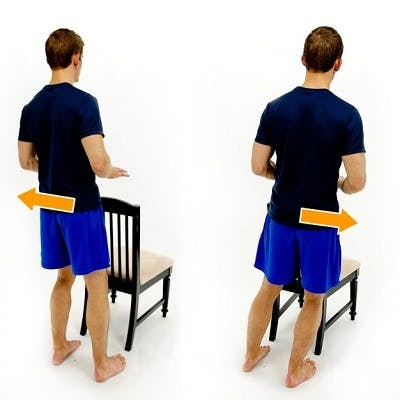
Weight shifts are great exercises for the early stages of brain rehabilitation. First, stand up with your feet shoulder-width apart and your weight equally distributed on both feet. Then, shift your weight to your right foot and lift your left foot slightly off the ground. Hold for up to 30 seconds or as long as you can while maintaining good form. Try to keep tall posture and avoid leaning over. Then return to your starting position and repeat about 5 times on each side.
Romberg Stance
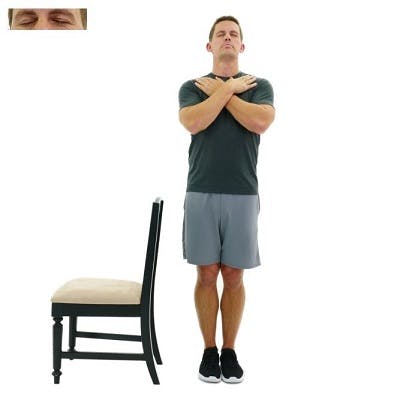
Stand with your feet touching together and eyes closed. (To ease into it, you can hold on to the back of a chair with both hands). The goal is to stand for 2 minutes, but only hold for as long as you can. You may feel your body sway when you close your eyes, but that is completely normal because your brain typically relies on your vision to help keep you oriented. When vision is removed, your brain has to adjust and use a different sense (proprioception) to help you balance. Thus, you are activating a different part of your brain which is great for TBI recovery.
Tandem/Staggered Stance
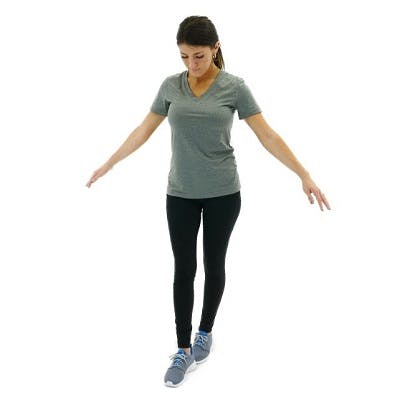
Another popular balance exercise for TBI survivors is the tandem stance. For this exercise, stand upright with one foot slightly in front of the other, with the heel of one foot lined up with the toes of the other. Hold for about 30-60 seconds, then switch to your other foot. If this is too difficult, try staggering your feet with a little more space between them. The wider your base of support is, the more stable you’ll feel. To increase the difficulty, you can try this balance exercise with your eyes closed.
Alternating Heel-Toe Raises

This TBI exercise strengthens your calves and ankle dorsiflexors, but helps you practice the heel-to-toe weight-shift that is needed for proper gait. To perform these, hold on to the back of a chair and rise to your tiptoes slowly for about 10 times, making sure to keep your weight equally distributed through both feet. To increase difficulty, you can close your eyes as well. These are especially helpful for brain injury rehabilitation because they can help improve your coordination and gait.
Arm Exercises for Traumatic Brain Injury Recovery
Now that we’ve gone through the mid- and lower-body, we will address the upper extremities with the following arm exercises for traumatic brain injury recovery.
Pushing Movement

Place a water bottle on the left side of the table within your range of motion. Then, hook your wrist on the outside of the bottle and use your arm to slowly push it straight across the table. With the same movement, push the bottle back in the opposite direction. Repeat 10 times on each arm.
Bicep Curls

For this TBI exercise, hold a water bottle in your hand and rest your arm by your side. Then with your elbow glued to your side, flex your bicep to bring the water bottle up to your shoulder. Finally, bring your arm back down as slowly as you can. By slowly performing the exercise, you’re developing more control and stability. Repeat 10 times on each side.
Shoulder Flexion
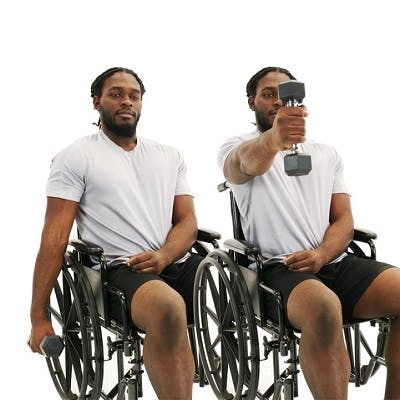
This TBI exercise can help strengthen your shoulder muscles after brain injury. First, hold a water bottle in your hand and rest your hand in your lap. Then, lift your arm up to a 90-degree angle in front of you until your hand is at your eye level (make sure your arm is fully extended). Hold for about 5 seconds, then slowly bring your arm back down to your lap. Repeat 10 times on each arm. If you’re feeling any pinching in your shoulder, check your posture and try lifting your arm up with your thumb rotated upward. This places the shoulder in a more neutral position that is less susceptible to impingement.
Shoulder Abduction

This is similar to the previous TBI exercise, but instead of lifting forward you’ll be raising your arm to the side. Both exercises can be done holding onto a water bottle, light weight, or a resistance band. While holding one end of the band, sit on top of the other end, or place it under one foot depending on the length of your band. Then, extend your arm (the one holding the band) straight out to your side. Loop the band around your hand to keep your grip. Finally, with your arm straight out, raise your arm as high as you can above your shoulder. Then with slow and controlled movement, bring it back down. Aim to repeat 3 sets of 10 exercises on each arm.
Cognitive Exercises for TBI Survivors
Instead of targeting the muscles, the following TBI exercises will help address cognitive function. Just as you can improve muscle function through rehab exercise, you can improve cognitive function through cognitive exercise.
Journal/Creative Writing
For this cognitive TBI exercise it helps to change your scenery. Try to find a relaxing location and sit outside with a journal. Take a moment to observe your surroundings and write down everything you see, hear, feel, and smell. This helps engage different areas of the brain and improve your concentration. You may write about the lush green of the grass, the smell of a nearby rose bush, the rough bark of a pine tree, or the soft breeze through your hair. If you are still working on your fine motor skills and cannot write yet, you can say your observations out loud. The goal is to pay close attention to your surroundings and stimulate the brain.
Spaced Retrieval
When memory is impaired after a brain injury, it can be challenging to follow a conversation. One of the best ways to help improve your memory is through spaced retrieval, an evidence-based technique that helps people recall information over progressively longer intervals. To practice this TBI exercise, first create flashcards with different information you want to learn and quiz yourself. This helps stimulate neuroplasticity, and with consistent practice, improves memory.
Puzzles & Board Games
Puzzles and board games are great fun ways to practice cognitive skills. They help challenge your memory, strategy, and problem solving skills. Board games are usually played as a group activity which adds a social dynamic for more cognitive stimulation. There are a variety of games you can try that can be done solo or with friends such as Chess, Sudoku, Scrabble, and Uno.
Cognitive Therapy Games
For extra motivation, you can use cognitive exercise apps such as the CT Cognitive Therapy App. It provides access to over 100,000+ cognitive rehabilitation exercises that help to improve speech, memory, and critical thinking skills. The more you practice high repetition of exercises, the sharper your cognitive skills will become.
While there are various types of activities for brain injury patients you can try, it’s important to consult with your therapist before performing any new exercises. Your therapist can provide guidance and ensure these TBI exercises are safe and suitable for your condition/ability level.
Getting Started with Exercises for Brain Injury Recovery
Exercising after a brain injury is important, but it’s equally important to find exercises that are suitable and effective for you. For example, if you perform exercises that are too challenging or result in symptoms such as pain, dizziness, headache, or nausea, it may be counter-productive and would be best for you to build your way up to it. However, if the exercises are too easy or unstimulating, it may not be enough to promote neuroplasticity and recovery after a TBI.
To maximize recovery, you must engage in exercises that stimulate neuroplasticity. This can include both active and passive exercises. Active exercises often require you to exert effort whereas passive exercises utilize the assistance of your unaffected side, therapist, or trained caregiver to help move your body.
Moving the body passively through its full range of motion helps stimulate the brain and activate neuroplasticity. Passive movements can also reestablish communication between the brain and body to help maximize chances of recovery from post-TBI paralysis or severe weakness.
Additionally, passive range of motion exercises can improve joint stiffness and muscle flexibility which can help prevent the development of contractures (a serious complication). While active exercises are usually performed alone, passive range of motion exercises can be done with or without the assistance of another person.
When choosing your TBI exercises for your home therapy regimen, it can help to think about the muscles you want to target and your ability level. Your therapist is also a great resource that can provide you with a customized rehabilitation plan with cognitive and physical therapy exercises best suitable for your condition.
Your therapist may also recommend therapy equipment to use at home in between therapy sessions, such as FitMi. This is an interactive neurorehabilitation device that helps improve mobility after TBI. FitMi provides full-body exercises that stimulate the brain and help you to accomplish high repetition, massed practice.
Engaging in Traumatic Brain Injury Recovery Exercises
After a TBI, survivors may struggle with physical and/or cognitive function. Fortunately, rehabilitation exercise has been proven to help improve these effects and promote recovery. Engaging in traumatic brain injury recovery exercises is key to maximizing your independence and restoring overall function. We hope this article helped you understand the benefits of exercising after a brain injury, and encouraged you to try out some of these TBI exercises. As always, be sure to consult with your therapist before performing any new exercises.










